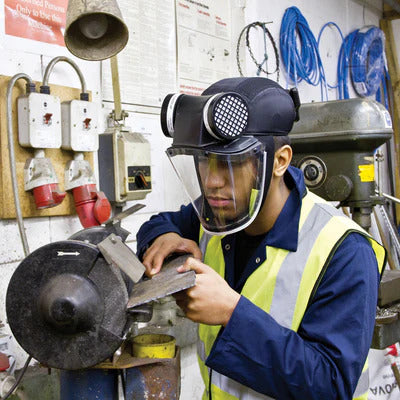There are many options available for respiratory protection, they all have a place but they are not all equal in the protection they offer. Just because you are wearing a mask does not mean it is suited for your application and may only be affording you limited protection. In this blog we will look at negative and positive pressure respirators, including advantages and disadvantages of each.
What is a Negative Pressure Respirator?
In simple terms a negative pressure requires the user to actively suck the air through the filter when they breathe in and direct all air through the filtering medium which filters out the impurities.
Negative pressure masks are the most common and come in 2 main styles, they are affordable and offer a great level of protection when fitted correctly and the filtration level matches the application.
Disposable Dust Masks - valved, non -valved, they also cater for a wide variety of applications and uses with the filtration levels offered including nuisance, N95, P1, P2, P3 and Carbon Activated being the most common.
Fitted Respirators - available as half and full face style mask, these offer a greater level of protection compared to a disposable mask
Advantages:
Affordable and easy to access.
Protect against a wide range of contaminants.
Disadvantages:
If a mask is not fitted correctly the user will draw contaminated air into the mask during inhalation.
Cannot be used with facial hair.
Cannot be used in high-risk environments like spraying Isocyanates.
Can become hot and uncomfortable during extended use
What is a Positive Pressure Respirator?
A positive-pressure respirator is a type of respiratory protection device in which positive air pressure is maintained within the facepiece while the device is in use and being worn properly.
In simple terms air is supplied to the respirator independent of the user's breathing creating a constant positive air pressure for the user to breathe in.
There are 2 different methods of air being supplied:
1/ Supplied Air Respirator (SAR) - Uses an external air supply like an air compressor and air is supplied via a breathing hose.
2/ Powered Air Purifying Respirator - (PAPR) - Battery powered. These actively pull air through their filters and push the air into the mask creating a continuous positive pressure.
Advantages
Highest level of protection
Supplies clean cool air - keeps the user comfortable all day long
Allows you to breathe as you normally would as the lungs are not labored to manually filter the air as they breathe.
No face fitting required - Can be used with facial hair.
SAR can be used in any application, the air supply just needs to be outside the contaminated area and used with an appropriate length air hose.
PAPR is portable and allows for great user flexibility and movement.
Disadvantages
High initial cost.
SAR have a long air hose that needs to be carried around.
PAPR cannot be used in areas of high contamination.
Understanding your environment and application, then matching it with the correct respirator will always give you the best protection.
Not sure what you need? Feel free to contact me matt@millin.co.nz and I would be happy to help find a solution.




